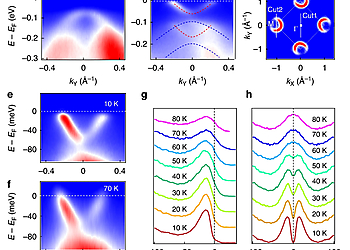Light Induced Non-Volatile Switching of Superconductivity in Single Layer FeSe on SrTiO3 Substrate
Result of the Month
The capability of controlling superconductivity by light is highly desirable for active quantum device applications. In this study Ming Yang et al. show that, in FeSe/SrTiO3 heterostructures, the superconducting transition temperature in FeSe monolayer can be effectively raised by the interband photoexcitations in the SrTiO3 substrate. The fast optical generation of superconducting zero resistance state is non-volatile but can be rapidly reversed by applying voltage pulses to the back of SrTiO3 substrate. The capability of switching FeSe repeatedly and reliably between normal and superconducting states demonstrate the great potential of making energy-efficient quantum optoelectronics at designed correlated interfaces.
This research was enabled by a Materials Innovation Platform (MIP) combining two MBE chambers, VT STM, LT STM, and a Scienta Omicron ARPES Lab including a DA30L-8000 and VUV5k. The complete system is included in the same UHV system with base pressure ~1 × 10−10 Torr. The importance of connected growth and analysis systems is evident as the authors also investigate a significant impact of capping samples: “…the UV enhancement of TC always saturated at around 30 K, which was still much lower than what was measured in uncapped films, indicating the leading bottleneck of TC in capped samples is likely related to the capping layer.”…” Additionally, ARPES data showed that the uncapped film had no hole pocket at the Γ-point, and the n-type doping was little changed as temperature varied (Supplementary Figure 6a, b). In contrast, the ex situ transport measurements performed on capped film revealed a co-existence of electrons and holes and a strongly temperature-dependent doping type (Supplementary Figure 6c)”.
Authors
Ming Yang1,2, Chenhui Yan1, Yanjun Ma1, Lian Li1 & Cheng Cen1
Institutes
1) Department of Physics and Astronomy, West Virginia University, Morgantown, West Virginia 26506, USA.
2) National Key Laboratory of Science and Technology on Power Sources, Tianjin Institute of Power Sources, Tianjin 300384, P. R. China.
Name and email of corresponding author
Prof. Lian Li, email: lian.li@mail.wvu.edu
URL of Institute web-pages
https://physics.wvu.edu/faculty-and-staff/faculty/lian-li
Publication(s)
NATURE COMMUNICATIONS (2019)10:85
URL of Journal(s)

